Recent discoveries of Galapagos Petrel nests on Isabela Island have sparked new optimism in the conservation of this critically endangered endemic species. This is a significant step forward in the protection of one of the archipelago’s most iconic seabirds. Their breeding habitat had been under constant threat for many years.
The team, led by experts of Galapagos conservancy along with rangers of Galapagos National Park explored possible nesting sites for petrels on the flanks the Sierra Negra volcano. This included both agricultural and protected areas.
A parte de un proyecto mas grande financiado por la National Fish and Wildlife Foundation (NFWF) para mejorar los habitats de anidacion de las petrelas de Galapagos, los miembros del equipo buscaron a fondo nuevos sitios de anidacion y tambien exploraron areas donde se habian registrado previamente nidos. El equipo tambien evaluo las amenazas que enfrenta la poblacion de petrelas en la isla. Las petrelas excavan grandes y profundas madrigueras en los densos suelos volcanicos en las partes altas de las islas donde construyen nidos simples en los que ponen sus huevos y crian a sus jovenes. Generalmente estan bien protegidas en sus madrigueras, pero enfrentan amenazas de ratas que comen a los polluelos e incluso a veces a los adultos, perros que excavan los nidos y plantas exoticas que pueden ahogar las madrigueras de anidacion de los petrelas.
Active Nests and Encouragement Signs of Recovery
During their expedition, the team found 11 nests in the National Park. Three of them showed signs of recent activity, such as feathers and droppings. Petrel chicks were also confirmed in several burrows found on local farms, which previously showed signs of activity. This is a major step forward for the recovery of this species. No photographs have been taken of petrel chicks nesting on Isabela Island. This population is genetically different from the four other nesting populations in Galapagos.
Other farms within the agricultural zone also had nests, which were clearly evidence of recent occupancy. These discoveries are vital for expanding our knowledge of the distribution and condition of petrels in Isabela Island.
Domenica Pinda, the leader of the expedition and a researcher at the Galapagos Conservancy, was excited to discover chicks inside the nests. She noted that this discovery gives hope for the recovery of the species. She said that, while there is much more work to do, the results of this expedition confirm we are on track to secure the future for petrels in Isabela Island.
Continued Threats
The presence of invasive animals and plants was one of the main challenges that the team encountered during the expedition. The team found a high concentration of invasive plants in most nesting sites, including guava, blackberry and signs of rats and insects. Nests were difficult to reach in these densely vegetated areas. Nests on local farms that were active were located in open areas. Typically, these nests are in pastures where cattle and horses graze to prevent the invasion of guava or blackberry plants.
Look Ahead
Galapagos Conservancy will continue to monitor nests of petrels and work closely with the Galapagos National Park Directorate in order to implement strategies for controlling invasive species. We will also soon be conducting new expeditions on Isabela Island to explore potential nesting sites. This will help us better understand the behavior and needs of these seabirds.
We reaffirm through these initiatives our unwavering dedication to the conservation and protection of Galapagos Petrels, as well as the ecosystems that are essential for their survival.
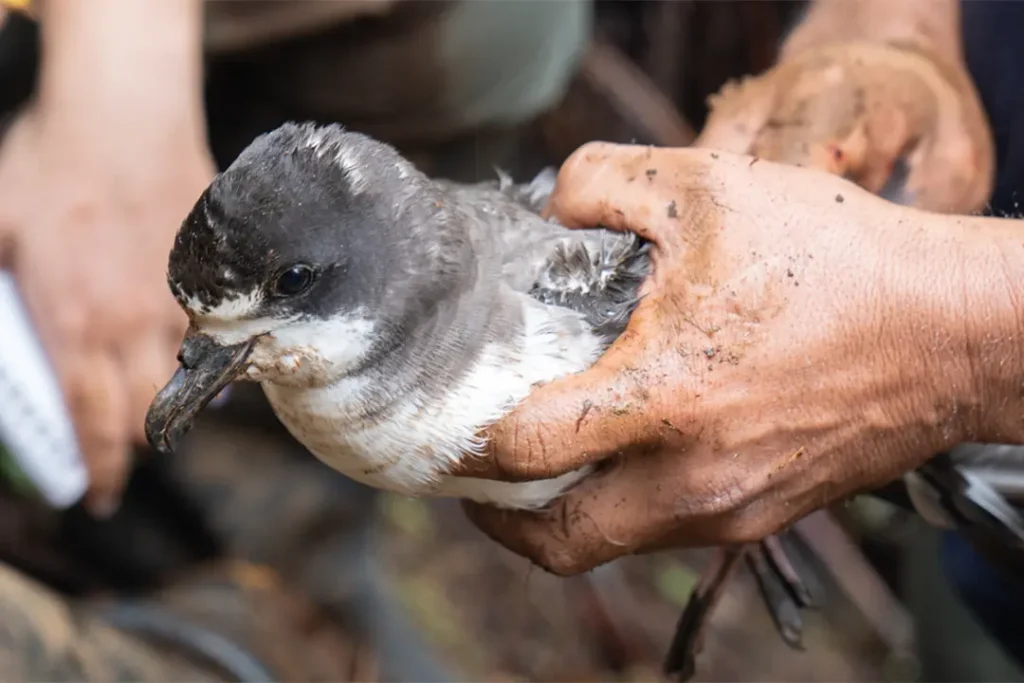
Galapagos Marine Reserve has a variety of unique species, which not only attracts thousands of tourists each year but are also vital to the health and wellbeing of the marine ecosystem. These species include the Galapagos Sea Lion ( Zalophus wollabaeki ) as well as the Galapagos Fur Seal ( Arctocephalus galapagoensis ). Both are found only on the Galapagos Islands and both are now endangered. Climate change and human activity, especially in areas near urban centres, are threatening these marine mammals.
Galapagos Conservation is committed to supporting efforts in the local community that help protect endangered and iconic species, such as pinnipeds from Galapagos. We support the pinniped research of Marjorie Riofrio, a researcher at the Universidad San Francisco de Quito. As part of the initiative, Dr. Riofrio educates local residents on sea lion conservation. She has recently led the creation and publication of a book for children titled “Loberto & Zally: Galapagos Sea Lions” to inspire readers to protect these species.
This story is about two sea lion siblings: Loberto, the playful pup, Zally, the curious older sister. Together, they explore the life of San Cristobal Island – home to the biggest sea lion colony on the archipelago. Together they face the challenges of growing in the Galapagos. They discover their unique environment and learn how to survive.
The book will be distributed to 200 school students on San Cristobal Island. Marjorie hopes that this educational tool will inspire future generations of people to play a role in the conservation efforts for the Galapagos Sea Lion. She explained that the book is not just a simple story, but an educational tool designed to promote scientific inquiry and strengthen ties between local communities with their environment.
Jenny Macias is the educational advisor for Galapagos Conservancy. She stressed that this project fits perfectly with their goals. By integrating the book in the Galapagos Contextualized Curriculum we inspire young minds to connect deeply to nature and realize the urgent need to preserve our valuable marine eco-system.
Galapagos Conservancy is committed to supporting conservation projects such as this. We congratulate Marjorie Riofrio for the launch of “Loberto and Zally”, which will encourage young people in Galapagos, to protect and preserve the iconic and loved sea lions and seals that call their home.
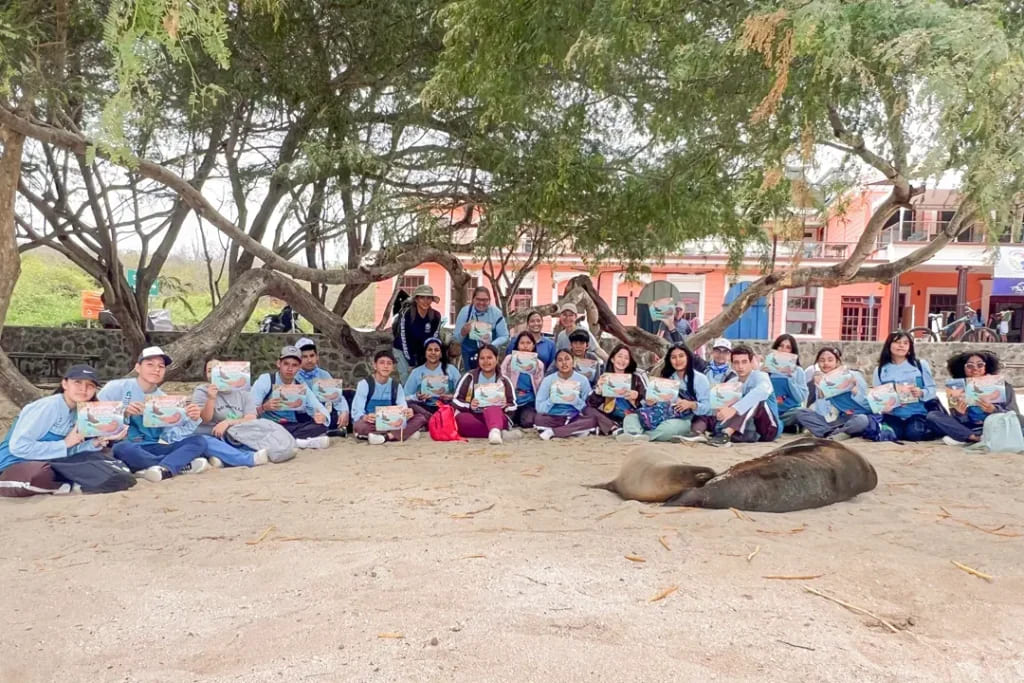
©Galápagos Conservancy
Grace Unda’s initiative is aimed at restoring and conserving vegetation that has exceptional water absorption properties and retention in the Cerro Gato Watershed. Her main strategy is to plant a mixture of Guadua Bamboo and a native and endangered shrub species, the Galapagos Miconia ( Miconia Robinsoniana). The Guadua stabilizes soil and prevents erosive erosion while the Miconia increases the soil’s capacity to retain water.
Grace also received guidance and support from the Galapagos Park Directorate. They donated native plants in addition to Galapagos Miconia. These include white wild coffee (Psychotria Rufipes), Scalesia trees (Scalesia pendulata), and Galapagos Guava (Psidium gallapageium). These plants are important to the local ecosystems in Galapagos because they provide food and shelter for wildlife. These plantings are strategic and help to strengthen the plant cover, restore indigenous plants, and reestablish hydrological cycles, which ensures the sustainability of water resources for the area. They also help restore habitats and encourage the growth of forests, which contributes to the mitigation of climate change.
The restoration of the local, freshwater source that is so important on San Cristobal Island shows how effective environmental solutions can be achieved through collaboration between institutions. Dr. Our Director of Conservation Jorge Carrion emphasizes the importance of community involvement in ensuring sustainability of conservation projects on the Galapagos. He says that by empowering local communities, we can build a better future for the Galapagos and the rest of the world. We promote a development model which balances the needs of the economy, the social and the environment.
This project shows what can be accomplished when organizations and communities unite to achieve a common goal, which is to preserve the Galapagos Islands’ unique ecosystems and services.
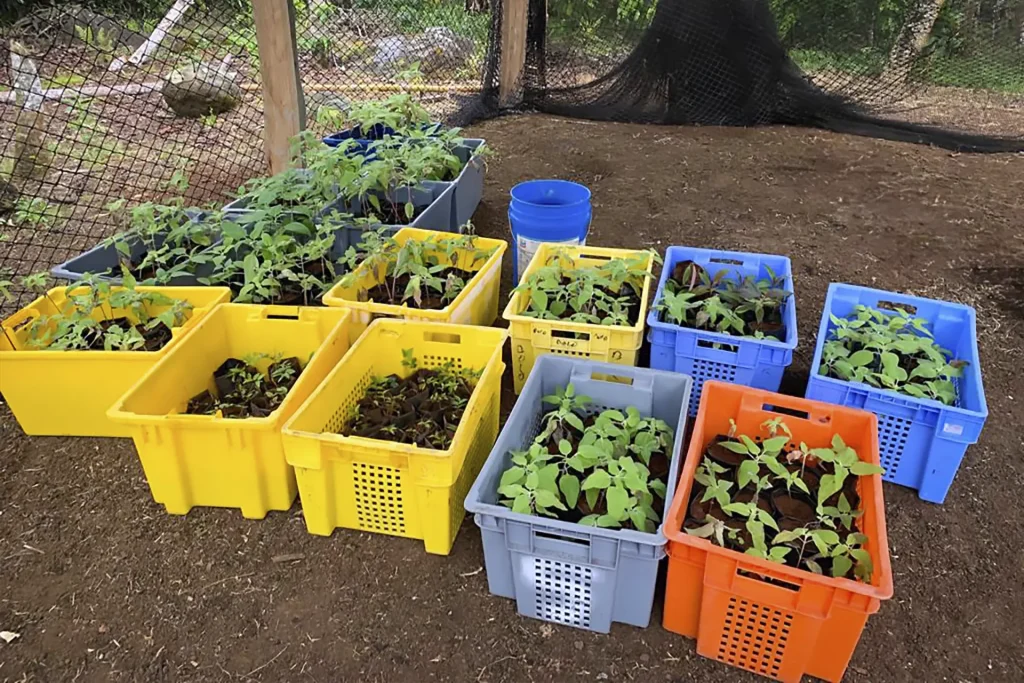
Yellow land iguanas ( Conolophus Subcristatus) are found on the Galapagos Islands. These large lizards can live up to 70-years in the wild. We must continue to intensify our efforts as we learn more about this fascinating creature. At Galapagos Conservation we are committed to protecting this incredible species in order to ensure its survival. The story of Yellow Land Iguanas is both a testament to the species’ resilience and a call to protect this incredible treasure.
Population and Distribution
Effective conservation requires that we know where and how many Yellow Land Iguanas are still alive. Information about the size of their populations, their habitats, their movement patterns and the connections between them helps us to develop better management strategies. We can also focus conservation efforts on the most important populations by identifying specific threats.
Yellow land iguanas are one of the three land iguana species found in Galapagos. They can be found nowhere else on Earth. The pink land iguana is the other species. The other two are the pink land iguanas (C. pallidus). Yellow land iguanas can be found on Isabela, Baltra, Fernandina, South Plaza, Santa Cruz, and Santiago Islands. Land iguana populations have declined throughout their range because of habitat destruction by goats and carnivores like feral cats and dogs. However, they still thrive on South Plaza Island and North Seymour Island where they were originally introduced from Baltra Island almost 90 years ago.
Successes in conservation and reintroduction
The land iguana on Santiago Island was exterminated by the middle of the 19th century. Charles Darwin reported the last sighting during his 1835 visit. It was feral pigs that were a major factor in the extinction of this species. Feral pigs were eradicated only in 2001. Since 2019, 3,143 Iguanas from North Seymour Island have been slowly introduced back to Santiago Island in order to restore this species and help the island to be restored.
Baltra Island was once home to a large population of yellow land Iguanas. They were known as the largest of their species. In the early 20th Century, however, this population decreased due to habitat destruction by feral goats introduced. During World War II, the situation became worse with the construction of an American military base on Balta. This led to the total disappearance of the iguanas.
In 1932-1933, the Baltra iguana population was decimated. Seventy iguanas, located just a half-mile away, were relocated to North Seymour. The American magnate William Randolph Hearst arranged this transfer. After noticing the decline of iguanas, and vegetation on Baltra due to goats, he decided to relocate them. This helped to prevent the extinctions of Baltra’s iguanas.
Baltra was repopulated in 1991 using iguanas that were bred from North Seymour during the 1980s. The program was a success: around 3,000 iguanas now live on Baltra.
Diet and Adaptations
Galapagos Land Iguanas are mostly herbivores. They feed on the green grasses and flowers of small shrubs and herbaceous plants. Invertebrates such as centipedes and spiders are also known to be eaten by these animals. Land iguanas are hydrated by eating Opuntia and other succulent plants.
Look Ahead
The Galapagos yellow land iguana is a symbol of resilience. It has adapted to and survived a difficult environment. Conservation efforts have enabled the species to start recovering and thrive in some places despite threats such as habitat loss and competition with invasive species. Galapagos Conservancy recognizes that protecting this species is a complex process, requiring research into its population, distribution and impact of invasive species. To preserve their habitats, and ensure their survival, it is essential to collaborate with the Directorate of Galapagos Park and others. It is vital that we protect this iconic species, and maintain its role as the cornerstone of Galapagos biodiversity for future generations.
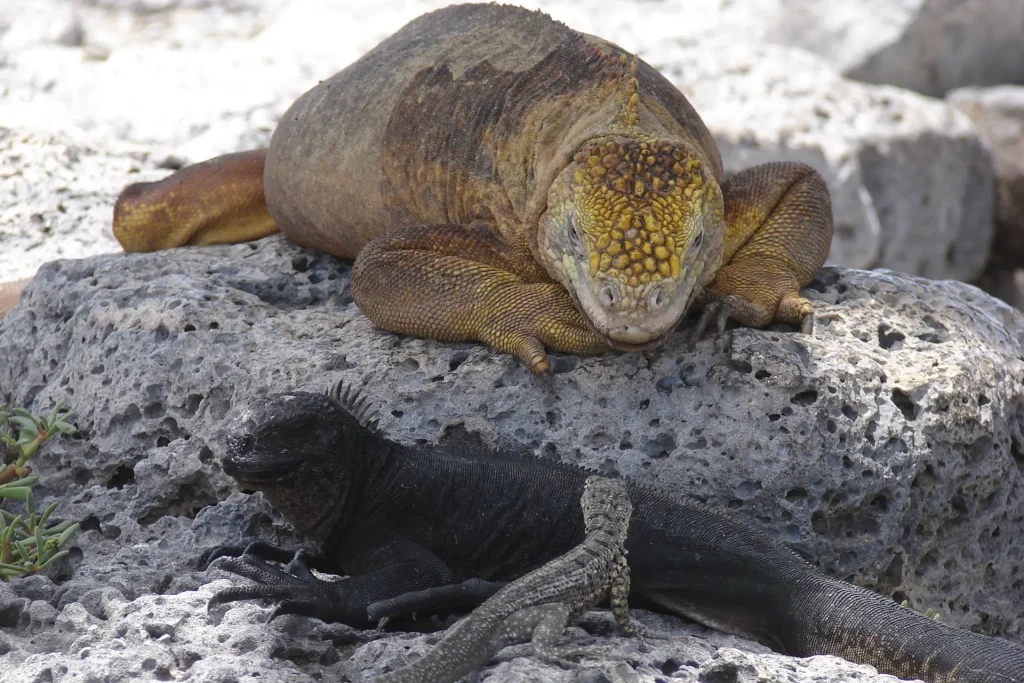
Satellite Animal Trackers: A Conservation Tool in Galapagos
Galapagos Conservation is committed to protecting the Galapagos Islands’ unique ecosystems. This commitment is reflected by our use of advanced technology in our conservation programs. This installment of our series on technological innovation highlights how satellite animal tracking is revolutionizing the conservation efforts of gigantic tortoises. These iconic species play a crucial role in the dynamics and ecology of the archipelago’s terrestrial ecosystems. These devices are state-of-the art and provide vital data to inform our conservation and management activities, improving our ability to protect and understand these majestic creatures.
Satellite Tracking in Conservation: A Revolution!
Satellite tracking devices have revolutionized the way we monitor endangered animals. These devices are small (2×2 inches), lightweight (7 ounces), and can be attached directly to adult tortoises’ shells without harming them. These devices are equipped with a GPS chip which records the tortoise’s location every six hours. The coordinates are then sent via satellite to enable us to track their movements in real-time and collect detailed information on their behavior.
Diego is a famous giant tortoise and a prime example of the technology being used in our conservation program. The GPS tracker on Diego’s shell, which was attached in June 2020 to his return to the wild Espanola Island after more than 80 years of captivity allowed our scientists to monitor Diego’s adaptation and ensure its well-being. Diego’s story illustrates how satellite tracking deepens our understanding of animals and their fate.
The giant tortoises of Isabela Island are another example of the impact this technology has had. The tracking of tortoises for two years revealed that males reached up to 1,200 meters in altitude and traveled up to 20 km. Females were more likely to move less and stay at lower elevations. These observations show behavioral differences in the sexes, and how climate change may affect their migration routes and impact their health and survival.
The advanced technology minimizes the need for physical presence by our researchers in sensitive habitats. This ensures that animals and habitats are not disturbed. This technology allows timely adjustments to ensure that conservation strategies are robust, responsive and effective as environmental conditions change.
The tracking devices not only provide valuable insight into the giant tortoises seasonal migrations but also highlight the role they play in the dispersal of seeds across the Galapagos. These devices show how tortoises, which retain the seeds that they eat for nearly a whole month in their digestive tracts, move slowly and steadily up to 1 km per day. This process is vital for the regeneration of vegetation and the health of the Galapagos ecosystems.
Conservation: Challenges and the Future
Satellite animal trackers are essential tools to help us better understand giant tortoises that live in remote, vast areas. These areas can be difficult to reach or monitor on the ground due logistical challenges. These ecosystems are isolated and require ongoing planning to protect them.
Future conservation efforts in the Galapagos depend on the integration of new technologies as well as the support of donors and supporters. Your commitment is vital to protect this unique archipelago, and to ensure that the Galapagos tortoises legacy endures for future generations.
Silent Guardians of Galapagos wildlife: Trail cameras
A Trail Camera Network in Galapagos
We have strategically placed trail cameras on several islands, including b>Isabela/b>, b>Santa Cruz/b> and ‘b>Santa Fe/b>. We have strategically placed cameras on several islands including Isabela Santa Cruz Santa Fe and Espanola. The cameras are in operation for several months and capture millions of images as well as data, such as the environmental conditions.
Use of trail cameras for research and monitoring
At Galapagos Conservancy, trail cameras play a vital role in our research. The cameras also help environmental authorities combat wildlife trafficking and poaching. Numerous cameras are positioned at key locations, including nesting sites of important species. This provides us with photographic evidence that documents animal activity and human trespass. Cameras are essential for protecting Galapagos fauna and flora.
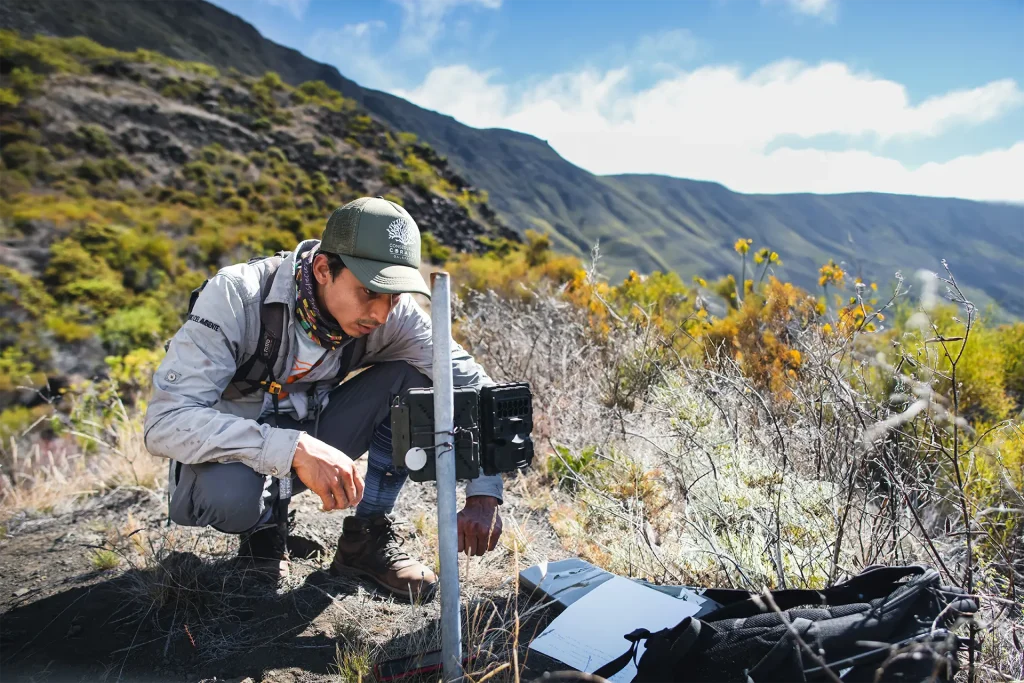
Photo: ©Galápagos Conservancy
Pink Iguanas: A Study
We have installed over 50 trail cameras on the Isabela Island slopes, the largest Galapagos Island. These cameras are used to monitor the habitats of Pink Iguanas. ( Conolophus Marthae ). The species was discovered in 1986, and described formally in 2009. It is an endemic of Galapagos. These images help us understand the natural history of the reptiles and the threats that they face.
The footage shows that cats are preying on the young iguanas when they leave their nests underground. The Galapagos National Park Directorate has used this important discovery to develop strategies for protecting hatchling pink Iguanas. This species is near extinction, with only 300 individuals left.
Analyzing images and converting them to data
Our proprietary software organizes and classes the millions of photos our cameras take to create a comprehensive report of what and where was found. This analysis gives us a deeper understanding of species rarity and abundance, population dynamics and behaviour. The cameras, which are set up for long periods of time, allow us to determine population trends and better understand wildlife needs. We can then adjust our conservation strategy and respond effectively to new challenges. Data-driven approaches are essential to developing accurate protection measures, and ensuring that Galapagos’ unique ecosystems are conserved.
Conservation in Galapagos: The Future
Galapagos Conservancy strives to improve our conservation efforts while expanding our technology. We can increase our monitoring abilities and raise global awareness by integrating trail cameras. This will help us gain support for protecting one of the most fragile ecosystems in the world.
We need to gather information in order to make informed decisions and adjust our strategies as necessary. In our next article, we’ll explore how we innovate our efforts in Galapagos with monitoring technology. These devices are complementary and provide us with crucial information on animal migration that helps us better understand the habitat requirements for several species.